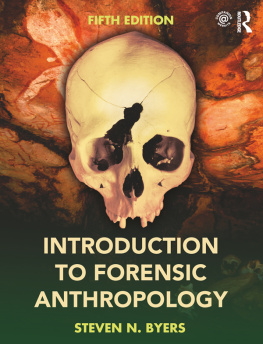Introduction to Library Research in Anthropology
Introduction to Library Research in Anthropology
John M. Weeks
First published 1991 by Westview Press
Published 2018 by Routledge
52 Vanderbilt Avenue, New York, NY 10017
2 Park Square, Milton Park, Abingdon, Oxon OX14 4RN
Routledge is an imprint of the Taylor & Francis Group, an informa business
Copyright 1991 by Taylor & Francis
All rights reserved. No part of this book may be reprinted or reproduced or utilised in any form or by any electronic, mechanical, or other means, now known or hereafter invented, including photocopying and recording, or in any information storage or retrieval system, without permission in writing from the publishers.
Notice:
Product or corporate names may be trademarks or registered trademarks, and are used only for identification and explanation without intent to infringe.
Library of Congress Cataloging-in-Publication Data
Weeks, John M.
Introduction to library research in anthropology / by John M.
Weeks.
p. cm.(Westview guides to library research)
Includes bibliographical references.
ISBN 0-8133-7454-5
1. Reference booksAnthropologyBibliography. 2. Anthropology
Bibliography. 3. AnthropologyResearch. I. Title. II. Series.
Z5111.W44 1991
[GN 42]
016.301dc20 90-24177
CIP
ISBN 13: 9/8-0-36/-01420-9 (hbk)
This book is an introduction to library research in anthropology written primarily for the undergraduate student about to begin a research project. There has long been a need for a practical guide to student library research in anthropology. This need has recently become more evident because of strong pressures being exerted on the academic environment. The mass lecture section, with computerized instruction and examinations, has reduced personal contact and close interaction between student and teacher. There is also a growing realization that the complexity of anthropological problems increases the need for individual analysis and independent thought
As the title indicates, this book was written as a guide and is certainly not intended to be an elaborate treatise on library -based anthropological research techniques. It is simply an introduction to the mechanics and resources of library use in order to assist students make efficient and thorough information searches. At the same time it is hoped the student will acquire some grasp of the flavor and importance of research so that its depth and value are more fully appreciated.
Large and, to some extent, intermediate academic libraries with their millions of books and specialized services can be confusing and intimidating. Learning to negotiate in a library is a problem for most students either entering or returning to college, for the upper division student beginning to concentrate on a major as well as for the graduate student whose undergraduate library was smaller and less complicated.
Much of the information presented in this book can be applied in other fields. The use of the library, the development of a research project, and the writing of the final paper are activities common to all social sciences. However, anthropological research is anthropological in character. Thus, adequate attention must be given to the special properties of research in this field.
and how they can be used during library-based anthropological research. The reader should be generally aware that a library may not have some of the resources identified, although most library reference works held at collegiate and university libraries should be included here.
The resource chapters are arranged in a standardized manner. Each chapter contains a summary description of the type of resource being discussed and its potential use in a research project. This statement is followed by appropriate subject headings to locate additional resources. The largest part of any chapter is devoted to an annotated list of resources arranged by anthropological subdiscipline, region, and then region by subdiscipline. For example, in general handbooks dealing with cultural/social anthropology (nos. 11.3-11.5) are presented before area handbooks about Africa (nos. 11.16-11.20). Handbooks about the anthropology of Africa (no. 11.21) are presented last.
The process of library research for student anthropologist! need not be a complicated process. There are obviously a wide variety of simple methods of library research that can be used by students with limited time and purpose. The purpose of these descriptive chapters is to lead the student researcher on an abbreviated tour of the basic kinds of library reference works and the range of materials available within these resource categories.
Three chapters have been written by specialists. , Online Databases, was written by Nancy K. Herther, a specialist in the application of electronic technologies in libraries at the University of Minnesota.
John M. Weeks
What Is Anthropology?
Nancy Johnson Black
When undergraduate students are asked what comes to mind when they think of "anthropology," their responses usually range from 200,000 year old Neanderthals to exotic locations such as New Guinea, and extend to Hollywood's swashbuckling version of the archaeologist, Indiana Jones. These associations reflect some aspects of this discipline that have been popularized in recent years. While it is encouraging to think that the discipline conjures up some kind of mental image for undergraduates, it is somewhat disconcerting as an anthropologist to realize that students are often disappointed because I do not wear a pith helmet or sarong, and am not wrapped in a python.
The roots of anthropology go back as far as the Greeks in the fourth century B.C., although the discipline with its recognized body of knowledge, theory, and professionalism did not emerge as a distinct field until the late nineteenth century. Many scholars credit the Greek historian Herodotus (488-425 B.C.), who studied Egyptian and Persian civilizations, as the founder of anthropology. Indeed, the name of the discipline is derived from the Greek, anthropos, human, and logos, account, conveying the efforts to describe and to explain the regularities in human behavior. By the twentieth century, anthropology was well established as an academic discipline.
From its very beginning, anthropology in the United States has been associated with academic institutions, museums, scientific associations and government. Many museums such as the Peabody Museum of Archaeology and Ethnology at Harvard University, the University Museum at the University of Pennsylvania, the American Museum of Natural History in New York, and the Field Museum of Natural History in Chicago, have had strong departments of anthropology. Several libraries have similarly developed major collections of anthropological literature. The primary anthropological collection in the United States is generally considered to be at Harvard University's Tozzer Library. According to the American Anthropological Association, the largest professional organization of anthropologists logical Association, the largest professional organization of anthropologists in the world, more than 300 colleges and universities in the United States offer a major in anthropology and many more offer anthropology courses. In 1988, approximately 4,000 undergraduate students received degrees in anthropology, and some 375 doctoral degrees in anthropology were awarded.









